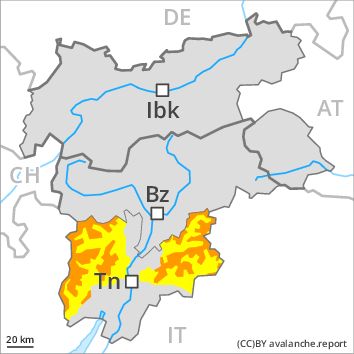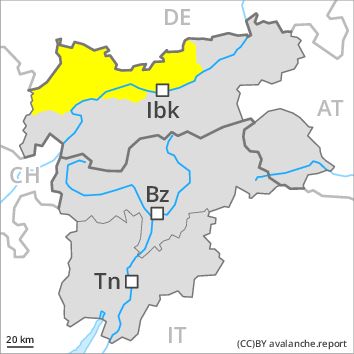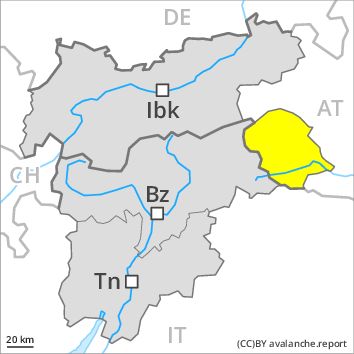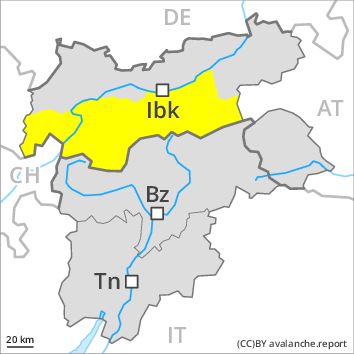Regions
Sexten Dolomites, Eastern Pfunderer Mountains, Durreck Range, Val Müstair Alps, Western Rieserferner Mountains, Langtaufers, Western Deferegger Alps, Schnals Ridge, Ortler Range, Southern Stubai Alps, Ulten Valley, Southern Zillertal Alps and High Tauern, Saldurn-Mastaun Ridge, Texel Mountains, Gröden Dolomites, Sarntal Alps, Prags Dolomites, Western Pfunderer Mountains

Danger level
Danger Level 3 - Considerable above 2200m
Danger Level 2 - Moderate above 2200m
Avalanche Problem
Wind-drifted snow above 2200m, N-NE-E-SE-S-SW-W-NW
Persistent weak layer above 2200m, N-NE-E-SE-S-SW-W-NW

The wind slabs are to be evaluated with care and prudence in particular in very steep terrain.
Fresh and somewhat older wind slabs must be evaluated with care and prudence in all aspects above approximately 2200 m. Avalanches can be released by a single winter sport participant and reach large size in isolated cases. The wind slabs are to be found in particular in gullies and bowls, and behind abrupt changes in the terrain. In isolated cases avalanches can be triggered in deep layers of the snowpack. The number and size of avalanche prone locations will increase with altitude. The current avalanche situation calls for careful route selection. In addition there is a danger of gliding avalanches.
Snowpack
dp 6: cold, loose snow and wind
In some cases the wind slabs have bonded poorly with each other and the old snowpack. Wind slabs are clearly recognisable to the trained eye. Transitions from a shallow to a deep snowpack where weaknesses exist in the old snowpack are especially precarious. Faceted weak layers exist in the old snowpack, in particular on steep, rather lightly snow-covered east, south and west facing slopes as well as adjacent to ridgelines above approximately 2200 m.
Tendency
Slight decrease in danger of dry avalanches.
Regions
Latemar, Southern Adamello, Primiero - Pale di S. Martino, Adamello - Presanella, Northern Brenta - Peller, Southern Brenta, Fassa Valley, Sole, Pejo and Rabbi, Southern Lagorai, Northern Lagorai, Maddalene, Paganella, Pine' - Mocheni Valley

Danger level
Danger Level 3 - Considerable above 2000m
Danger Level 2 - Moderate above 2000m
Avalanche Problem
Wind-drifted snow above the treeline, N-NE-E-SE-S-SW-W-NW
Gliding snow above 2200m, N-NE-E-SE-S-SW-W-NW

The wind slabs represent the main danger.
The fresh and somewhat older wind slabs are in many cases extensive and in some cases prone to triggering. Even single persons can release avalanches as before, in particular adjacent to ridgelines. Ski touring and other off-piste activities, including snowshoe hiking, call for experience in the assessment of avalanche danger and careful route selection, in particular on steep slopes above approximately 1800 m as well as on wind-loaded slopes. In steep terrain there is a danger of falling on the icy crust. Below approximately 2200 m small and, in isolated cases, medium-sized gliding avalanches are possible.
Snowpack
The wind slabs have formed in particular in gullies and bowls, and behind abrupt changes in the terrain. These are in many cases extensive and in some cases prone to triggering. In some cases the various wind slabs have bonded still only poorly with each other and the old snowpack. The snowpack will be moist below approximately 2200 m.
Tendency
A latent danger of gliding avalanches exists, in particular at the base of rock walls below approximately 2200 m.
Regions
Prealps, Cembra Valley, Bondone and Stivo, Vallarsa, Western Nonsberg Alps, Folgaria - Laverone, Ledro Valley, Eastern Nonsberger Alps, Northern Dolomites of Fiemme, Marzola - Valsugana

Danger level
Danger Level 2 - Moderate
Avalanche Problem
Wind-drifted snow above the treeline, N-NE-E-SE-S-SW-W-NW
Gliding snow above 2200m above 1800m, N-NE-E-SE-S-SW-W-NW

The fresh and somewhat older wind slabs must be evaluated with care and prudence in all aspects.
The fresh and somewhat older wind slabs are in some cases extensive and to be assessed with care and prudence. Even single persons can release avalanches in isolated cases, in particular adjacent to ridgelines. Ski touring and other off-piste activities, including snowshoe hiking, call for meticulous route selection, in particular on steep slopes above approximately 1800 m as well as on wind-loaded slopes. In steep terrain there is a danger of falling on the icy crust. Below approximately 2000 m mostly small gliding avalanches are possible.
Snowpack
The wind slabs have formed in particular in gullies and bowls, and behind abrupt changes in the terrain. These are in many cases extensive and in some cases prone to triggering. In some cases the various wind slabs have bonded still only poorly together. The old snowpack remains in most cases moist.
Tendency
A latent danger of gliding avalanches exists, in particular on steep grassy slopes below approximately 2000 m.
Regions
Karwendel Mountains, Western Lechtal Alps, Central Lechtal Alps, Grieskogel Mountains, Allgäu Alps, Eastern Lechtal Alps - Ammergau Alps, Mieming Mountains

Danger level
Danger Level 2 - Moderate
Avalanche Problem
Wind-drifted snow above 2400m, N-NE-NW
Gliding snow above 2600m, E-SE-S-SW-W

Wind slabs require caution, especially adjacent to ridgelines.
The more recent wind slabs can be released, especially by large additional loads, in particular on northwest to north to northeast facing aspects above approximately 2400 m. Mostly avalanches are medium-sized. The avalanche prone locations are to be found in particular adjacent to ridgelines. They are rather rare and are clearly recognisable to the trained eye. The wind slabs in very steep terrain are to be bypassed. Transitions from a shallow to a deep snowpack are unfavourable.
Slight increase in danger of gliding avalanches as a consequence of warming during the day. Small to medium-sized gliding avalanches are possible. This applies in particular on steep grassy slopes, especially on east, south and west facing slopes below approximately 2600 m, but in isolated cases also on steep shady slopes below approximately 2000 m.
As a consequence of warming during the day and solar radiation more small and, in isolated cases, medium-sized moist loose snow avalanches are possible, in particular on rocky slopes below approximately 2800 m.
Snowpack
dp 6: cold, loose snow and wind
dp 2: gliding snow
The snowpack will be subject to considerable local variations at high altitudes and in high Alpine regions. The more recent wind slabs have bonded quite well with the old snowpack. Wind slabs are lying on soft layers, in particular on shady slopes at high altitudes and in high Alpine regions. The snowpack will become increasingly moist, especially on very steep sunny slopes below approximately 2800 m.
Tendency
Further decrease in danger of dry avalanches. Slight increase in danger of gliding avalanches.
Regions
Glockner Range, Eastern Deferegger Alps, Schober Mountains, Lienzer Dolomites, Venediger Range, Eastern Rieserferner Mountains

Danger level
Danger Level 2 - Moderate
Avalanche Problem
Wind-drifted snow above 2600m, N-NE-NW
Gliding snow above 2600m, E-SE-S-SW-W

Wind slabs require caution, especially adjacent to ridgelines.
The more recent wind slabs can be released, especially by large additional loads, in particular on northwest to north to northeast facing aspects above approximately 2600 m. Mostly avalanches are medium-sized. The avalanche prone locations are to be found in particular adjacent to ridgelines. They are rather rare and are clearly recognisable to the trained eye. The wind slabs in very steep terrain are to be bypassed. Transitions from a shallow to a deep snowpack are unfavourable.
Slight increase in danger of gliding avalanches as a consequence of warming during the day. Small to medium-sized gliding avalanches are possible. This applies in particular on steep grassy slopes, especially on east, south and west facing slopes below approximately 2600 m, but in isolated cases also on steep shady slopes below approximately 2000 m.
As a consequence of warming during the day and solar radiation more small and, in isolated cases, medium-sized moist loose snow avalanches are possible.
Snowpack
dp 6: cold, loose snow and wind
dp 2: gliding snow
The wind will be moderate in some localities. The snowpack will be subject to considerable local variations at high altitudes and in high Alpine regions. The more recent wind slabs have bonded quite well with the old snowpack. Wind slabs are lying on soft layers, in particular on shady slopes at high altitudes and in high Alpine regions. The snowpack will become increasingly moist, especially on very steep sunny slopes below approximately 2800 m.
Tendency
Further decrease in danger of dry avalanches. Slight increase in danger of gliding avalanches.
Regions
Western Tuxer Alps, Eastern Tuxer Alps, Glockturm Range, Weißkugel Range, Western Verwall Mountains, Gurgler Range, Central Stubai Alps, Eastern Verwall Mountains, Northern Zillertal Alps, Silvretta, Samnaun Mountains, Northern Oetz and Stubai Alps

Danger level
Danger Level 2 - Moderate
Avalanche Problem
Wind-drifted snow above 2600m, N-NE-NW
Gliding snow above 2600m, E-SE-S-SW-W

Wind slabs require caution, especially adjacent to ridgelines.
The more recent wind slabs can be released, especially by large additional loads, in particular on northwest to north to northeast facing aspects above approximately 2600 m. The avalanche prone locations are to be found in particular adjacent to ridgelines. They are rather rare and are clearly recognisable to the trained eye. The wind slabs in very steep terrain are to be bypassed.
Dry avalanches can additionally be released in deeper layers by large loads. This applies in particular on steep south facing slopes above approximately 2800 m as well as on steep east and west facing slopes above approximately 2400 m. In particular transitions from a shallow to a deep snowpack are unfavourable. Mostly avalanches are medium-sized.
Slight increase in danger of gliding avalanches as a consequence of warming during the day. Small to medium-sized gliding avalanches are possible. This applies in particular on steep grassy slopes, especially on east, south and west facing slopes below approximately 2600 m, but in isolated cases also on steep shady slopes below approximately 2000 m. As a consequence of warming during the day and solar radiation more small and, in isolated cases, medium-sized moist loose snow avalanches are possible.
Snowpack
dp 6: cold, loose snow and wind
dp 2: gliding snow
The wind will be moderate in some localities. The snowpack will be subject to considerable local variations at high altitudes and in high Alpine regions. The more recent wind slabs have bonded quite well with the old snowpack. Wind slabs are lying on soft layers, in particular on shady slopes at high altitudes and in high Alpine regions. Faceted weak layers exist in the old snowpack in particular in areas where the snow cover is rather shallow. This applies in particular adjacent to ridgelines as well as on steep east, south and west facing slopes at high altitudes and in high Alpine regions. The snowpack will become increasingly moist, especially on very steep sunny slopes below approximately 2800 m.
Tendency
Further decrease in danger of dry avalanches. Slight increase in danger of gliding avalanches.
Regions
Brandenberg Alps, Western Kitzbühel Alps, Wilder Kaiser Mountains - Waidring Alps, Eastern Kitzbühel Alps

Danger level
Danger Level 1 - Low
Avalanche Problem
Gliding snow, E-SE-S-SW-W

Gliding snow requires caution.
A certain danger of gliding avalanches and moist snow slides exists. This applies in particular on steep grassy slopes, especially on east, south and west facing slopes, but in isolated cases also on steep shady slopes below approximately 2000 m. Areas with glide cracks are to be avoided. Small to medium-sized gliding avalanches are possible.
As a consequence of warming during the day and solar radiation more small and, in isolated cases, medium-sized moist loose snow avalanches are possible.
The more recent wind slabs can be released in isolated cases, but mostly only by large additional loads, in particular on extremely steep shady slopes at high altitude. Restraint should be exercised because avalanches can sweep people along and give rise to falls. The avalanche prone locations are clearly recognisable to the trained eye.
Snowpack
dp 2: gliding snow
The various wind slabs have bonded generally well together. The snowpack will become increasingly stable. This also applies at high altitude. The snowpack will become increasingly moist, in particular on very steep sunny slopes.
Tendency
Currently there are quite favourable conditions generally.







